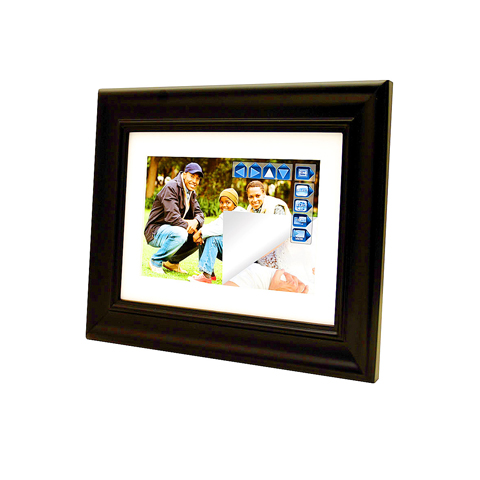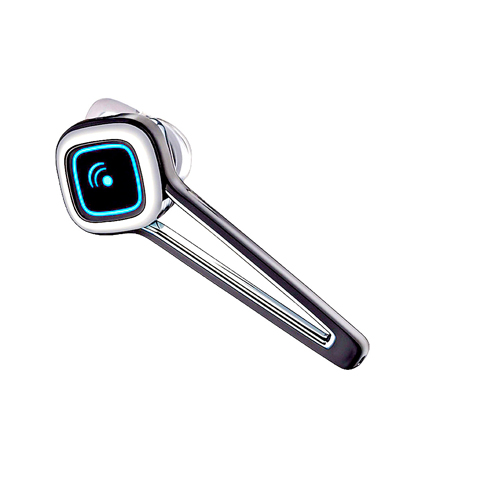Touch-sensitive surfaces seem to be everywhere these days, so why not in digital photo frames? Pandigital has just released a line of frames with touch-sensitive functions.
The 10.4-inch PanTouch High-Definition Digital Photo Frame displays images at a healthy resolution of 1,024 by 768 pixels and has no external buttons — you slide your finger along the matte frame to switch pictures and make selections. The US$250 device also includes a remote control and 512 megabytes of built-in storage.
Also in the PanTouch line are a US$120 7-inch model with 128MB of memory and a US$170 8-inch model with 512MB. All of them have versatile memory card readers and alarm clock functions.

PHOTO: NY TIMES NEWS SERVICE
The frames, which will reach stores next month, also play MP3 music files and video.
With the addition of a Wi-Fi or Bluetooth adapter, you can upload images wirelessly from a computer as well as from Bluetooth-compatible phones and PDAs.
While a touch frame doesn’t sound as cool as a touch screen, it definitely means fewer on-screen fingerprints.

PHOTO: NY TIMES NEWS SERVICE
Plantronics has been a leader in adding style to Bluetooth headsets. The latest in its Discovery line, the 925, aims to add even more style as well as substance, in the form of audio quality.
In fact, company officials would prefer that it not be referred to as a headset. They call it an earpiece, because they want consumers to think of it as a fashion accessory.
It comes in black, cherry or gold, with cases to match. These are the spring colors; the company says it will change the colors every season.

PHOTO: NY TIMES NEWS SERVICE
The Discovery 925 is available now for US$150, at plantronics.com.
The controls have also been simplified so that one button does most of the work, like turning the unit on and off. The same button answers and hangs up the phone. The volume control is the only other button.
Another form/function enhancement is the carrying case, which doubles as a charger. Without removing the unit from its case, you can connect it to a computer via USB or charge it using the included AC adapter.
Kodak is coming out with the Z1085 IS, a slim, 0.170kg camera with a 5X optical zoom and several built-in features to make snapshots look more professional.
In automatic mode the camera uses face detection and shake reduction to ensure that each shot is in focus. In fact, the face-tracking system on this model displays a green animated box that follows faces in the frame. Once a shot is taken, a bit of software automatically cleans up the image and reduces the effects of backlighting, which can darken images, or overexposure, which can wash them out. There are other scene modes for night shooting or taking pictures of fireworks or sunsets.
The Z1085 IS also takes high-definition video at 1280 by 720 pixels. Video can be recorded to the memory card and edited on a PC or watched on an HD television using an optional HD dock.
The camera has a 2.5-inch liquid-crystal display monitor and 32 MB of internal memory. It supports SD cards for memory expansion. It costs US$250 online and in stores.
While the average Kodak user does not care about ISO or shutter speed, it is nice to know at least someone is thinking about — and tweaking — these functions using built-in software.
Apple may be aiming at metalheads with its thin MacBook Air, but Asus is chasing the leather crowd. Asus’ ultralight laptop, the U2E, has black-pebbled leather on the top and the palm rest. The refined look is meant to evoke the days when travelers wouldn’t leave home without their leather valises and trunks.
The U2E is lighter than the Air, about 1.2kg versus 1.4kg, in part because of its smaller screen, about 11 inches versus 13 inches, and a tighter keyboard. The sides aren’t tapered to an edge like those on the Air, because the U2E comes with all of the standard connectors and a DVD-R drive. The square edges make it seem much thicker than the Air, although it is only a half-centimeter fatter.
The U2E costs US$1,999 now, but in a few weeks a version with a 32-gigabyte flash drive will go on sale. At US$2,699, that will be more expensive, but also 0.3kg lighter because it sheds the heavy metal of the hard disk drive.

June 23 to June 29 After capturing the walled city of Hsinchu on June 22, 1895, the Japanese hoped to quickly push south and seize control of Taiwan’s entire west coast — but their advance was stalled for more than a month. Not only did local Hakka fighters continue to cause them headaches, resistance forces even attempted to retake the city three times. “We had planned to occupy Anping (Tainan) and Takao (Kaohsiung) as soon as possible, but ever since we took Hsinchu, nearby bandits proclaiming to be ‘righteous people’ (義民) have been destroying train tracks and electrical cables, and gathering in villages

Dr. Y. Tony Yang, Associate Dean of Health Policy and Population Science at George Washington University, argued last week in a piece for the Taipei Times about former president Ma Ying-jeou (馬英九) leading a student delegation to the People’s Republic of China (PRC) that, “The real question is not whether Ma’s visit helps or hurts Taiwan — it is why Taiwan lacks a sophisticated, multi-track approach to one of the most complex geopolitical relationships in the world” (“Ma’s Visit, DPP’s Blind Spot,” June 18, page 8). Yang contends that the Democratic Progressive Party (DPP) has a blind spot: “By treating any

Swooping low over the banks of a Nile River tributary, an aid flight run by retired American military officers released a stream of food-stuffed sacks over a town emptied by fighting in South Sudan, a country wracked by conflict. Last week’s air drop was the latest in a controversial development — private contracting firms led by former US intelligence officers and military veterans delivering aid to some of the world’s deadliest conflict zones, in operations organized with governments that are combatants in the conflicts. The moves are roiling the global aid community, which warns of a more militarized, politicized and profit-seeking trend

This year will go down in the history books. Taiwan faces enormous turmoil and uncertainty in the coming months. Which political parties are in a good position to handle big changes? All of the main parties are beset with challenges. Taking stock, this column examined the Taiwan People’s Party (TPP) (“Huang Kuo-chang’s choking the life out of the TPP,” May 28, page 12), the Democratic Progressive Party (DPP) (“Challenges amid choppy waters for the DPP,” June 14, page 12) and the Chinese Nationalist Party (KMT) (“KMT struggles to seize opportunities as ‘interesting times’ loom,” June 20, page 11). Times like these can